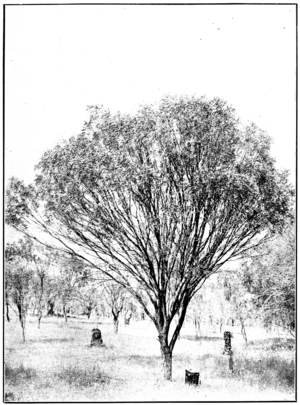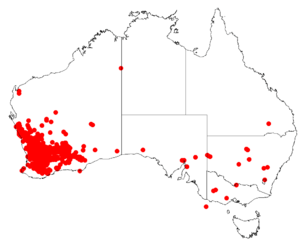Jam tree facts for kids
Quick facts for kids jam tree |
|
|---|---|
 |
|
| mature tree in native habitat, circa 1920 | |
| Scientific classification | |
| Genus: |
Acacia
|
| Species: |
acuminata
|
 |
|
| Occurrence data from AVH | |
The jam tree, also known as Acacia acuminata or mangart, is a special tree found only in Western Australia. It belongs to the Fabaceae family, which includes many types of peas and beans. This tree grows mostly in the southwest part of Western Australia, especially in an area called the Wheatbelt. It can also be found in drier, semi-desert areas.
Contents
What the Jam Tree Looks Like
Acacia acuminata can grow as a tall bush or a small tree. It usually reaches a height of 3 to 7 meters (about 10 to 23 feet). In perfect growing spots, it might even grow up to 10 meters (33 feet) tall. However, in most places, it stays under 5 meters (16 feet).
Like many Acacia species, this tree does not have true leaves. Instead, it has what are called phyllodes. These are flattened leaf stems that look and act like leaves. The jam tree's phyllodes are bright green and about 10 centimeters (4 inches) long. They are quite narrow, only about 2 millimeters (0.08 inches) wide, and they end in a long, pointy tip.
The tree produces bright lemon-yellow flowers. These flowers grow in tight, cylinder-shaped clusters, each about 2 centimeters (0.8 inches) long. The jam tree blooms from late winter through spring. After flowering, it grows light brown, flat pods. These pods are about 10 centimeters (4 inches) long and 5 millimeters (0.2 inches) wide. They appear during the summer.
The seeds of the jam tree are shiny and dark brown or black. They are very nutritious! About 45% of a seed is protein, 28% is fat, and 15% is carbohydrates.
How the Jam Tree Got Its Name
The Acacia acuminata was first officially described in 1842 by a scientist named George Bentham. He based his description on samples collected by James Drummond.
The name acuminata comes from a Latin word meaning "pointed" or "elongated." This name refers to the long, pointy tip at the end of each of the tree's phyllodes.
The common name raspberry jam tree comes from the strong smell of its freshly cut wood. It smells a lot like raspberry jam! Because of this, it is also called "fine leaf jam" or simply "jam tree."
The Noongar people, who are the traditional owners of the land where this tree grows, have several names for it. They call it Manjart, Munertor, Mungaitch, or Mungat.
Scientists recognize a few slightly different types of Acacia acuminata:
- A. acuminata (small seed variant)
- A. acuminata (narrow phyllode variant)
- A. acuminata (broad phyllode variant / typical variant)
Growing the Jam Tree
The jam tree is quite tough and can handle different weather conditions. It is very good at resisting frost and can also tolerate some salt in the soil. It is also good at surviving dry periods, known as droughts.
For the jam tree to grow well, it needs at least 250 millimeters (about 10 inches) of rain each year. It prefers to grow in soils that can be dry for part of the year. If there is a fire, the jam tree usually does not grow back from its stump.
The wood of the jam tree is very special. It has that distinct smell of raspberry jam. It is also very strong and lasts a long time, even when placed in the ground. This makes it a popular choice for fence posts. The wood also has a beautiful grain, which is the pattern you see in the wood, making it good for crafts.
The jam tree is often used as a "host tree" in plantations where sandalwood (Santalum spicatum) is grown. Sandalwood trees need another plant to grow near them to help them get nutrients.
Where the Jam Tree Lives
The jam tree is found all over the southwest part of Australia. It also extends into the drier, central areas called the Eremaean province.
In 1863, an explorer named Henry Lefroy noticed that the jam tree was very common between Narembeen and the Avon River. It often grew alongside sandalwood trees. Later, in 1895, a forest expert named John Ednie Brown estimated that about four million acres of land were covered by jam trees and Eucalyptus loxophleba (York gum).
In 1882, Surveyor General Malcolm Fraser created the first detailed map of where the jam tree grew. He found it from Champion Bay in the north all the way south to the Gordon River. He also noted that farm animals like cattle would eat the seeds and young shoots of the tree.
Uses of the Jam Tree
The wood of the jam tree is hard, strong, and has a beautiful reddish color with a close grain. It has been used for many things over the years.
Traditional Uses
The Noongar people considered the jam tree a very valuable resource. They used its wood, seeds, and sap.
- Food: The many seeds were collected and ground into flour.
- Medicine: The sap from the tree was gathered and used as medicine. It could be used right away or prepared and stored for later.
- Tools and Weapons: The wood was a favorite for making kylies, which are a type of boomerang weapon.
Modern Uses
When European farming expanded in Australia, the jam tree's wood became very important for fence posts. This is because it is very resistant to termites, which are insects that eat wood. Many fences made from jam tree wood are still standing after more than 100 years! In the 1920s, a forest conservator named Charles Lane-Poole noted how long-lasting these fence posts were. Farmers also learned that where jam trees grew, the land was good for growing wheat and raising sheep.
The wood's strength and beauty also made it useful for other things:
- Construction: It was used for high-load items like sheave blocks (parts of pulleys).
- Crafts and Furniture: The wood has an attractive grain, similar to the blackwood tree (Acacia melanoxylon). It was used for making pipes, walking sticks, staircases, and furniture.
- Firewood and Charcoal: The jam tree is also a good source of firewood. In 1877, Ferdinand von Mueller noted its value for making charcoal. During World War II, when petrol was rationed, this charcoal was even used to power special gas-producing engines in cars.
The jam tree is also used today in sandalwood (Santalum spicatum) plantations in the Wheatbelt region. It acts as a "host tree" for the sandalwood.
Animal Food
The seeds of the jam tree are eaten by regent parrots (Polytelis anthopeplus).
Jam Tree in Nature
The jam tree can be a host for certain types of mistletoe plants, which are plants that grow on other plants. Scientists have studied this relationship, especially with mistletoe species like Amyema fitzgeraldii and Amyema preissii.
Images for kids
-
Acacia acuminata near Yeerakine Rock
See also
 In Spanish: Acacia acuminata para niños
In Spanish: Acacia acuminata para niños



